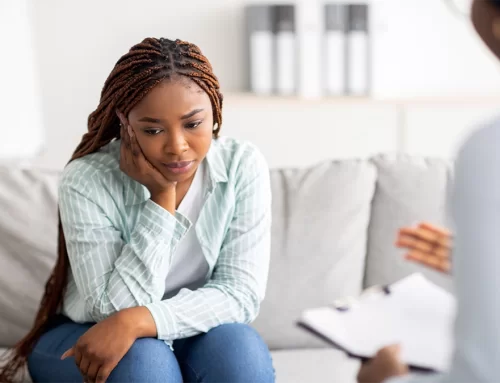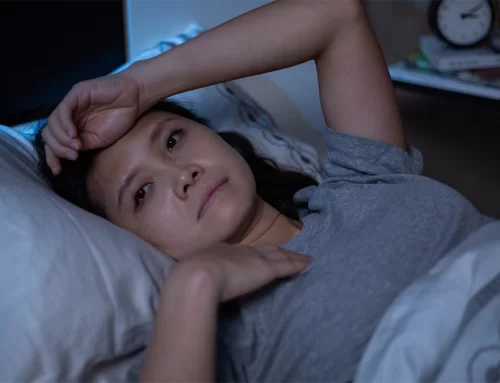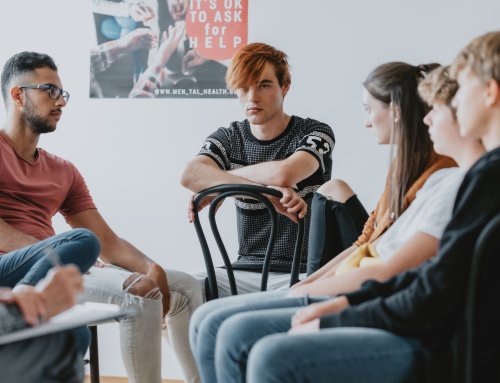June is PTSD Awareness Month, and every year on June 27, we recognize National PTSD Awareness Day. The SAMHSA (Substance Abuse and Mental Health Services Administration) honors this month, which is all about helping people learn what PTSD is, how it affects lives, and, most importantly, how you or someone you care about can get help.
PTSD is something that can happen after you go through a traumatic or scary event. This could be anything from a car accident to a natural disaster, a sexual assault, or even time spent in war. It doesn’t matter if you’re a Veteran or a civilian, PTSD doesn’t choose who it affects.
Even though PTSD treatments do work, many people never get the help they need. That’s why this month is recognized – to spread the word, educate others, and urge people like you to take the first step.
How PTSD Awareness Month Got Started
National PTSD Awareness Day was first recognized by the U.S. Senate in 2010, and by 2013, the whole month of June was set aside to raise awareness. The goal was clear: make sure people know what PTSD is and what can be done about it.
Here in the U.S., about 6.8% of adults will have PTSD at some point in their lives. Women are more likely than men to experience it, often because of sexual trauma. Veterans are also deeply affected. For example, about 30% of Vietnam War veterans, 10% of Gulf War veterans, and 14% of Iraq War veterans have had PTSD. These numbers show just how important it is to talk about this issue.
What You Can Do
- Learn about the symptoms of PTSD. Knowing the signs can help you recognize it in yourself or someone close to you.
- Explore treatment options. Today, there are many proven ways to feel better, like therapy, medication, and support groups.
- Take a PTSD self-screen. The U.S. Department of Veterans Affairs offers a simple online tool with just 5 questions. It’s quick and private, and it can help you find out if what you’re feeling might be PTSD. (You can find it on their website.)
- Share what you learn. The more people know about PTSD, the more likely someone struggling will reach out for help.
Why Awareness Matters
On June 27 and throughout June, agencies like the U.S. Department of Defense, healthcare providers, and community organizations come together to share information. Their goal is to make sure that you and others know there is help out there. The more we talk about PTSD, the more likely people are to recognize it, seek help, and feel better.
Introduction to PTSD and Its Causes
PTSD is a mental health condition that can happen after someone goes through a very scary or upsetting event. These events are often called “traumas.” They might include things like serious accidents, natural disasters, violence, war, or losing someone close.
Not everyone who experiences trauma gets PTSD, but for some people, the memories and feelings from the event stay with them for a long time. This can make it hard to feel safe, relax, or enjoy life.
PTSD can happen to anyone (men, women, children). It’s a normal response to very uncommon situations.
Common causes of PTSD include:
- Combat or war experiences
- Physical or emotional abuse
- Serious accidents or injuries
- Natural disasters like floods or earthquakes
- Witnessing violence or death
Being aware of what causes PTSD can help us be more patient and supportive of those who are dealing with it.
How to Spot Symptoms in Yourself or a Loved One
PTSD symptoms usually start soon after a scary or upsetting event, but sometimes they don’t show up until months or even years later. The symptoms can come and go over time. If these problems last longer than 4 weeks and make life hard, like causing big stress or making work and home life difficult, it might be PTSD.
There are four main types of PTSD symptoms, and to be diagnosed, a person usually has some of each type. But everyone’s experience can be different.
1. Reliving the Event
You might have bad memories or nightmares about what happened. Sometimes, it can feel like the event is happening again, which is called a flashback. Things like certain sounds, smells, or places can remind you of the trauma and cause these memories to come back suddenly. For example, fireworks might remind a person of gunfire.
2. Distancing From Trauma-associated Places or People
You may avoid places, people, or activities that remind you of what happened. For example, if someone were in a car accident, they might avoid driving or riding in a car. Sometimes people stay very busy or don’t get help because they don’t want to think about the trauma.
3. Struggling With Negative Thoughts and Feelings
After trauma, people can have more sad or angry thoughts than before. You might feel numb and not enjoy things like you used to. Sometimes people forget parts of the event or feel like the world is very unsafe. They might also feel guilty or ashamed, wishing they could have stopped what happened.
4. Experiencing Hyperarousal
You might feel jumpy, easily startled, or always on the lookout for danger. It can be hard to sleep or concentrate. Some people get angry easily or do things that aren’t healthy, like smoking too much or using drugs.
What About Children?
Kids can show PTSD in different ways depending on their age:
- Young children (under 6 years old) may get upset when their parents are not nearby, have trouble sleeping, or act out the scary event through their play.
- Children ages 7 to 11 might also act out the event in their drawings or stories, have nightmares, or become more irritable or aggressive. They may want to avoid school or have trouble with friends.
- Teens (ages 12 to 18) often have symptoms like adults, such as feeling sad or anxious, pulling away from others, or doing risky things like using drugs or running away.
If you or someone you care about shows these signs, it’s important to reach out for help. PTSD can be treated, and no one has to face it alone.
Modern Treatment Options for PTSD
Good news: PTSD can be treated, and there are many ways to help people feel better. Here are some of the common treatments used today:
1. Cognitive Behavioral Therapy (CBT)
Studies suggest that this type of talk therapy, where you work with a therapist to change the way you think about the trauma, helps PTSD sufferers learn new ways to cope with their feelings. One common method is Prolonged Exposure Therapy, which helps people safely face memories and situations they have been avoiding so they can reduce their fear and distress over time.1
2. Medications
Doctors sometimes prescribe medicines to help with PTSD symptoms. These can include antidepressants like fluoxetine, paroxetine, and venlafaxine. Another medicine, prazosin, can help with nightmares and sleep issues.2
3. Eye Movement Desensitization and Reprocessing (EMDR)
In this therapy, you focus on moving your eyes in certain ways while thinking about the trauma. This helps your brain process painful memories and reduce their power over you. Evidence suggests EMDR is as successful as CBT in helping people with PTSD.3
4. Narrative Exposure Therapy (NET)
With NET, you tell the story of your life, including the traumatic events, to face and understand them better, helping you organize your memories and reduce the emotional impact they have on you.4
5. Mindfulness-Based Stress Reduction (MBSR)
Studies found that MBSR helps you learn how to stay calm and focused in the present moment, which can ease stress and anxiety from PTSD by teaching you techniques to manage overwhelming emotions and improve your overall sense of well-being.5
6. Holistic and Supportive Therapies
Other helpful treatments include art and music therapy, animal-assisted therapy (spending time with pets or therapy animals), exercise, and joining support groups where you can share your experiences with others who understand.
These treatments can be used alone or together, depending on what works best for each person. If you or someone you know has PTSD, talking to a doctor or mental health professional is a great first step to finding the right help.
TasteRecovery offers a safe, supportive residential treatment center designed to meet your needs and help you start fresh. Healing begins with one step; make that step today.
Sources:
- McLean, C. P., Levy, H. C., Miller, M. L., & Tolin, D. F. (2022). Exposure therapy for PTSD: A meta-analysis. Clinical Psychology Review, 91(91), 102115. https://doi.org/10.1016/j.cpr.2021.102115
- Forman-Hoffman, V., Middleton, J. C., Feltner, C., Gaynes, B. N., Weber, R. P., Bann, C., Viswanathan, M., Lohr, K. N., Baker, C., & Green, J. (2018, May). Evidence Summary. Nih.gov; Agency for Healthcare Research and Quality (US). https://www.ncbi.nlm.nih.gov/books/NBK525135/
- Evanthia Asimakopoulou, Panagiotis Theodosis-Nobelos, & Triantis, C. (2024). Advances in the management of posttraumatic stress disorder after critical illness: a narrative review. Emergency and Critical Care Medicine, 4(4), 174–182. https://doi.org/10.1097/ec9.0000000000000139
- Forman-Hoffman, V., Middleton, J. C., Feltner, C., Gaynes, B. N., Weber, R. P., Bann, C., Viswanathan, M., Lohr, K. N., Baker, C., & Green, J. (2018). Psychological and Pharmacological Treatments for Adults With Posttraumatic Stress Disorder: A Systematic Review Update. In PubMed. Agency for Healthcare Research and Quality (US). https://pubmed.ncbi.nlm.nih.gov/30204376/
- Burback, L., Brémault-Phillips, S., Nijdam, M. J., McFarlane, A., & Vermetten, E. (2023). Treatment of posttraumatic stress disorder: A state-of-the-art review. Current Neuropharmacology, 22(4). https://doi.org/10.2174/1570159×21666230428091433




